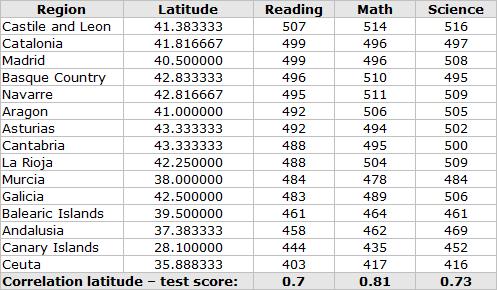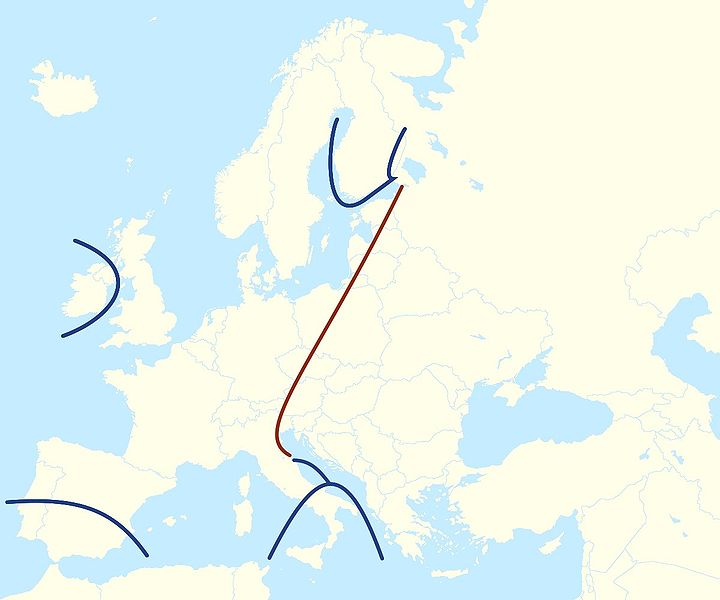there appears to be a north-south divide in spain on several crucial metrics. for example, pisa scores (good proxy for iq scores/intelligence — see here and here):
gdp per person (2012 — from here):
poverty:
the speculation in hbd circles has long been that these differences have something to do with southern spain’s moorish history vs. northern spain’s visigothic, later catholic, one. but now, from the upcoming american society of human genetics conference, we have this:
so, if this proves to be correct, the major genetic divide in spain is an east-west one, not a north-south one! as razib pointed out:
https://twitter.com/razibkhan/status/643188951491018752
why, then, the apparent north-south divide in spain (if it’s real)?
not sure. but there is another major difference between northern and southern spain, and that is in the traditional mating patterns/family types — southern spain is (traditionally) outside the hajnal line, while northern spain falls within it:
in other words, northern spain has for a long time been marked by the western european marriage pattern — i.e. late marriage, fewer children — whereas southern spain has not. from what i can tell, this late marriage pattern is found in those areas of europe in which bipartite manorialism was present during the medieval period, but i honestly don’t know if this holds for spain/the iberian peninsula. i shall endeavor to find out! jayman found, btw, that iq scores in europe correspond pretty well to the hajnal line — higher scores within, lower scores outside the line. this also appears to be the case in spain:
high historic rates of cousin marriage also tend to be present outside the hajnal line. historians generally agree that very close endogamous marriage practices were common in moorish spain — fbd marriage even — and they continued right up into (at least) the sixteenth century.
perhaps regional differences in mating patterns/family types persisted in spain despite the movement of peoples during the reconquista. it could be that northerners who moved south through the country, replacing (or eventually outnumbering) the moors, adopted closer mating habits as they moved southwards. it wouldn’t be the first time, i don’t think, that a transplanted group adopted the marriage practices of the broader host population.
dunno. all still speculative at this point. watch this space! (^_^)
see also: Mapping The 2009 PISA Results For Spain And Italy from the reluctant apostate and IQ Ceilings? from jayman.
previously: northern vs. southern spanish iq, redux and la endogamia en la españa medieval and inbreeding in spain in the 19th & 20th centuries and big summary post on the hajnal line
(note: comments do not require an email. medieval spain.)





[…] spain’s north-south divide? […]
Oh just wait… ;)
Also, additionally, check out this one source for neglected little Portugal
If their indicators are accurate, unlike its neighbor Spain, Portugal doesn’t appear to have much of a north-south divide. If anything, there appears to be an east-west divide there. Now how about that? How do you explain that pattern?
Also of interest, check out my earlier post More on Farming and Inheritance Systems – Part I: IQ.
Southern Spain (and for that matter, Southern Italy) sits largely south of the 0° C isotherm during the winter. That changes quite a bit when it comes to farming. Clarkian selection for intelligence was likely much more relaxed there compared to the north.
@jayman – “Southern Spain (and for that matter, Southern Italy) sits largely south of the 0° C isotherm during the winter. That changes quite a bit when it comes to farming. Clarkian selection for intelligence was likely much more relaxed there compared to the north.”
weeeellll…maybe. but, two things:
1) as always, it’s more than just smarts. corruption is also higher in southern spain than in the north (see here – pgs. 8-9 plus the appendices). as with corruption in places like china, i think there’s more going on than just selection for intelligence.
2) if the climate/environment (and how easy or difficult agriculture was thanks to the climate/environment) mattered the most for intelligence/clannishness, then the irish (and the welsh…and the cornish, for that matter) ought to be more like the english on those measurements, but they’re not.
no doubt they matter, but i think there’s more to selection pressures on humans than just the climate/environment. (~_^)
Its pretty shocking how Moorish Spain has been turned into utopia by starry-eyed modern muslim lovers, who incidentally despise the Gothic and Catholic influence on Spain. They are like a bunch of starry-eyed cultists. If you even suggest to them that Moorish Spain was not the multicultural paradise they imagine it to be, they go into vicious attack mode.
Really weird modern phemonenon I wish someone would write about.
Jayman / hbdchick
“Southern Spain (and for that matter, Southern Italy) sits largely south of the 0° C isotherm during the winter. That changes quite a bit when it comes to farming. Clarkian selection for intelligence was likely much more relaxed there compared to the north.”
Interesting point – things like two crops per year maybe (no frosts) in some places and only one further north.
“if the climate/environment (and how easy or difficult agriculture was thanks to the climate/environment) mattered the most for intelligence/clannishness, then the irish (and the welsh…and the cornish, for that matter) ought to be more like the english”
It might work if you imagine overlapping layers – say a north-south temperature layer and an east-west rainfall layer with the very heavy Atlantic rainfall creating a clannish cattle zone along the western edge of Europe.
(high rainfall leaches the soil making it acidic and wheat doesn’t like acid soils)
So your core zone is north but also away from the coast.
Gnarlodious
“Really weird modern phemonenon I wish someone would write about.”
It’s interesting how the PC hierarchy of ethnicities never has to be listed.
They seem to know instinctively.
I’d imagine this is significant somehow.
East-west divide in Portugal is coast vs mountains.
Northern Spain industrialized, while central and southern never really did. That could be an effect of IQ variation, but it could also be a driver of IQ variation. Another possibility is that ambitious southern-spaniards went to America over the period 1500-1800, while those in the north had less opportunity (or push) to do so.
“Strikingly, the major axis of genetic differention in Spain runs west to east, while conversely there is remarkable genetic similarity in the north-south direction.”
This is a very key finding, and let me explain why:
I’ve been getting a lot of confused commenters over at my latest piece at Unz (Clannishness – the Series: Zigzag Lightning in the Brain). Basically, many are bewildered by the success of NW Euros over other groups because NW Euros weren’t always so successful. They don’t understand that evolution can proceed fairly quickly (or at least a lot quicker than they’re imagining).
But we here we see that the major gradient of genetic/ancestral differences in Spain is perpendicular to the gradient in IQ, clannishness, and other key traits! This is strong evidence for recent evolution (within the last few centuries), because this indicates that, despite being different genetically, people in adject corners of Spain (along the east-west direction) nontheless developed similarities in key traits. In other words, convergent evolution.
This, by the way, applies for all of Europe.
The reason people seem to have different outcomes in the past is because they were different in the past!
@jayman Don’t assume that farming is any easier in the south of Portugal (and Spain): summers are our winters. The climate is very hot and dry, water is scarce. In harder summers wells were locked and guarded at night, water rationed to keep cattle and poultry alive until the first rains in September, maybe October. After the cereal was harvested in the beggining of summer there were not many new food sources, so the cuisine is based on water + bread + whatever meat was preserved (salted, smoked) from the pigs slaugthered in the winter. My childhood summers were plagued by soup of stale bread and weeds. Or stale bread, goat cheese hard as stone and weeds. Winter and spring were the times of plenty, but resources had to be managed during the summer. Things were like this at least until the 1950s. Then most people went to live on the cities on the coast. Even now about once every 10 years comes a particularly bad dry season and cattle dies, orchards are lost. Would a winter in the Netherlands be a stronger selective pressure than this?
The east/west divide we get in Portugal is mostly the result of a centuries-long migration to the coast as the interior has always failed to develop a viable economy – the resources are just not there.
The north/south divide is different. There are the obvious ethnic differences. Linguistically we talk about the cordeiro/anho line (the word used for “lamb”) that runs right where the Hajnal line is and divides two different language zones. Some of the differences were imported from Italy, as there was a north /north (soldiers and traders) and south/south (land owners) migration during the Roman period. I must say that I don’t recognize the Hajnal line in practice – maybe I don’t know enough about family structures and so on. I would love to know what sources were used to draw it there. Perhaps there are other factors that are more important here, like land ownership, matriarchy vs patriarchy and religiousness.
If you look at PISA results by region you will get the east/west divide, not the north/south divide.
Sorry for the rambling comment :)
[…] This was pretty interesting over at HBD Chick’s: the genetics of the american nations. Dig them graphics. And moar of ’em with spain’s north-south divide? […]
@zmoreira
“The north/south divide is different. There are the obvious ethnic differences. Linguistically we talk about the cordeiro/anho line (the word used for “lamb”) that runs right where the Hajnal line is and divides two different language zones. Some of the differences were imported from Italy, as there was a north /north (soldiers and traders) and south/south (land owners) migration during the Roman period. “
The genetics runs cross the IQ/clannishness divide. It’s not an ethnic difference that does the trick.
“Don’t assume that farming is any easier in the south of Portugal (and Spain): summers are our winters. The climate is very hot and dry, water is scarce. In harder summers wells were locked and guarded at night, water rationed to keep cattle and poultry alive until the first rains in September, maybe October. “
Well, average IQ is not very high across the Arab world. And they live in an actual desert.
In response to Gnarlodious: Moorish Spain in the South was more agricultural than Christian Spain in the North, which was more pastoral. In civilizational accomplishment, the Moors were better at STEM, better at food production (farming), and better at philosophy. This of course has to do with a vis-a-vis comparison between the educated elites. All this means nothing, when it comes to measuring the IQs and other themes mentioned on this blog, when it comes to our modern day Iberian peninsula. The Moors were completely driven out of Spain after the Reconquest, and intermarriage between the Moriscos (converted Catholic Moors) and Christian Spaniards were rare. Spaniards have a lot more to boast about, when it comes to their Jewish ancestry.
It does means one thing, however, in which after the Reconquest, the Spaniards took over the Moorish territory and continue the farming activity left by the Muslims, which were concentrated mostly in the south in Andalusia, and the southwest in places like Valencia.
Me thinks lower IQs, propensity for inbredness and tribalism are correlated with warmer climates and/or farming societies. Furthermore, agricultural settings are not conducive to book learning than urban areas, because they don’t require it.